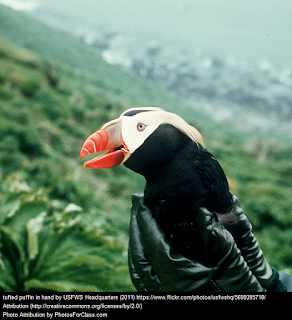 |
Tufted Puffin in Hand.
8 May 2011. Tufted Puffins, Alaska. By USFWS.
|
Population 2,750,000-3,000,000
9/3 on Continental Concern Score. Most populated in the San Juan Islands,
Strait of Juan de Fuca, and along the coast of the Olympic Peninsula.
The Tufted Puffins migrate to the Islands in spring and summer,
this is their mating season and a time to raise their young. To survive they typically dive into waters (up
to 100 km) for their food and can typically hold about 20 or more smaller fish
at a time.
These birds are known to populate regions of waters all
around the coastal areas of the United States, but there has been a significant
decline between the 80s -90s. A study was started in 2005 to observe their “reproductive
trends” (Pearson 2005) on Tatoosh Island, Washington. To see if their trends
produced normal patterns the case study was compared to that of other seabirds.
Breeding sites in Washington were recorded that only 48% in 2007
and 53% in 2008 were actually active. (Pearson 2005) In 2007 fewer Puffins returned to the
colonial areas in Tatoosh Island to, and this caused a decline in the amount of
birds that would breed.
Fishing nets are one of largest contributors to the killings
of the Tufted Puffin, it is estimated (in 1980s) that about 10,000 get trapped
in large fishing nets. Since then the mortality rate had dropped but not
significantly. Natural predators of the Tufted Puffin are from arctic foxes,
bears, and otters which were not native to these areas until early 1900s. These
predators have often eliminated the populated areas of Puffins from several
islands.(Eckhardt 2015)
Another reasons for the decline of the Puffin are from oil spills,
specifically in 1991 the Tenyo Maru spill had effected an estimated 9% of the
Puffin Population. Ocean temperatures
are rising and this is reducing the productivity of the fish populations making
it more difficult for the Puffin to survive.
At this time there are no plans of management of recovery
requirements but they are considered a species of concern “by the U.S. Fish and
Wildlife Service.”(Hanson 2015) The Endangered Species Act will not be
evaluated for the Tufted Puffin to make the list until 2017. If the Tufted
penguin continues to decline at the 8.9% annual rate then it they will become
extinct in the next 40 years.
The reason I chose this bird is because I remember seeing so many of them when I was in Oregon at the Haystack Rock. I had no idea they were on the brink of being on the endangered species list. They have quails that fan out as a display to attract a mate. They typically only have one to two broods annually, which does not help the population growth at a fast pace.
Works Cited:
Eckhardt, M. (2015). Tufted
Puffin. R. Bonney, Ed. Retrieved October 07, 2016, from
https://www.allaboutbirds.org/guide/Tufted_Puffin/id
Hanson, T. and G. J. Wiles. 2015. Washington state status report for the Tufted Puffin. Washington
Department of Fish and Wildlife, Olympia, Washington. 62 pp.
Pearson, Scott. Dr. Hodum, Peter and Dr. Parrish, Julia. 2005.
Tufted Puffin Status and Trends. Washington
Department of Fish and Wildlife, Olympia, Washington. Web.
Hi Jamie,
ReplyDeleteGreat blog post, what a beautiful bird! I had no idea these guys weren't doing well, but from your information I can kind of understand why. Species that can't grow in population quickly are sensitive to changes in their environments. If too many of them are killed off by threats in the environment then there isn't enough of them to keep up breeding rates. I hope more will be done in the future for these birds, it's sad that a species has to get on the endangered list to really get the attention it needs.